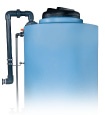Maintaining the proper temperature of a chemical inside a polyethylene storage tank is often critical for safe storage. For example, sodium hydroxide and caustic soda need to maintain certain temperatures to prevent crystallization.
Topics:
Fittings and Accessories
Proper tank design is crucial to successful safe chemical storage. Purchasing a chemical storage tank isn’t just about selecting the right size — it is vital to design the proper tank configuration for the safety of your employees, the protection of the environment, and to leverage your investment.
Topics:
Value Added,
Tank Design and Materials
Sodium hydroxide, also known as lye or caustic soda, is used to neutralize the pH of water in a variety of applications. Sodium hydroxide is produced by the electrolysis of brine or by reacting sodium carbonate with calcium hydroxide. The chemical leaves no residual color, is a high-strength product, and is available at concentrations of two to 50 percent. Most of our customers use it in 25 to 50 percent concentrations.
Topics:
Chemicals
Peracetic acid is a bactericide and fungicide that is used in the food industry and water treatment industry. It’s a potent chemical that must be treated with care and stored properly. Improper handling could be costly and result in personal injury.
Topics:
Chemicals,
Chemical Storage
This is the third article in Poly Processing’s Innovation Series, where you’ll discover the many innovations that we have introduced to the chemical storage industry. If you manufacture, sell or distribute water treatment or distribution products in North America, your products typically must comply with NSF/ANSI 61. NSF/ANSI 61 sets the criteria for water system components to protect health standards. It’s important that all components in water treatment meet the correct standards to ensure dangerous toxins aren’t leached. However, there is confusion about NSF-61 certifications, and that confusion could lead to purchasing the wrong product for your application. Let’s explore NSF/ANSI 61 and how to make sure your chemical storage tank system meets the necessary requirements.
Topics:
Value Added
Proper venting of a chemical storage tank system helps ensure safe operation and can also extend the useful life of the cross-linked polyethylene (XLPE) tank. Poly Processing Company sees venting as one of the most critical parts of a safe chemical storage system. We also attach venting labels to tanks manufactured at our facilities to emphasize the critical importance of proper venting.
Topics:
Venting,
FAQs
Sulfuric acid is one of the most widely used chemicals in the United States. More sulfuric acid is produced every year than any other chemical. It has a multitude of industry-specific uses, such as the production of other chemicals, dyes and pigments, water and water treatment, and fertilizers.
Topics:
Applications
Mixing chemicals and other substances is a lot like mixing cake batter. A container is involved, as is a stand (or bracket) to support the mixing system. But, if you’ve ever made a cake, you know that you have to move the bowl around to mix all the ingredients. It doesn’t work to stick the beaters down in the bowl and keep them in one place.
Topics:
Fittings and Accessories
Poly Processing works diligently to produce each and every chemical storage tank to spec. But if a tank isn’t installed correctly it could lead to damage, leaks, safety issues for personnel, and a shorter tank life. Everyone should take chemical tank installation seriously.
Topics:
Value Added,
FAQs
How do you know when it’s time to replace your polyethylene storage tank, instead of repairing it? No matter what chemical tank manufacturer you use, there are hidden costs to replacing a damaged tank. At some point, it’s less expensive to replace the tank — but that could be years later than you might think. Many companies only calculate the tank purchase cost and shipping costs when deciding whether to repair or replace a chemical storage tank, but there are several additional factors to consider as well. Let’s look at these overlooked factors that contribute to your total cost.
Topics:
Value Added



